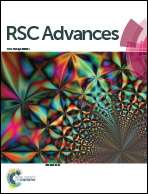Effects of substrates on proton irradiation damage of graphene
Abstract
In this paper, the irradiation damage of graphite sheets and monolayer graphene on Cu and Ni substrates after the proton irradiation with High Intensity D–T Fusion Neutron Generator (HINEG) were studied. The microstructure evolution of graphite sheets and monolayer graphene on different substrates was analyzed using Raman spectroscopy, X-ray photoelectron spectroscopy (XPS), and transmission electron microscopy (TEM). Results showed that the peak area ratio of carbon-oxides (C–O, C![[double bond, length as m-dash]](https://www.rsc.org/images/entities/char_e001.gif) O) in graphene was reduced after irradiation. 2–50 nm nanopores were produced in monolayer graphene on both Cu and Ni substrates. The results of Raman spectroscopy showed that the relationship between D and G peak intensity ratios (ID/IG) of irradiated graphene on diverse substrates was ID/IG(Cu) < ID/IG(Ni) < ID/IG(graphite), which indicated that the proton irradiation damage of graphene on the Cu substrate was the lightest. The reason for this could be speculated to be that different substrates had different damage self-repairing capabilities.
O) in graphene was reduced after irradiation. 2–50 nm nanopores were produced in monolayer graphene on both Cu and Ni substrates. The results of Raman spectroscopy showed that the relationship between D and G peak intensity ratios (ID/IG) of irradiated graphene on diverse substrates was ID/IG(Cu) < ID/IG(Ni) < ID/IG(graphite), which indicated that the proton irradiation damage of graphene on the Cu substrate was the lightest. The reason for this could be speculated to be that different substrates had different damage self-repairing capabilities.



 Please wait while we load your content...
Please wait while we load your content...